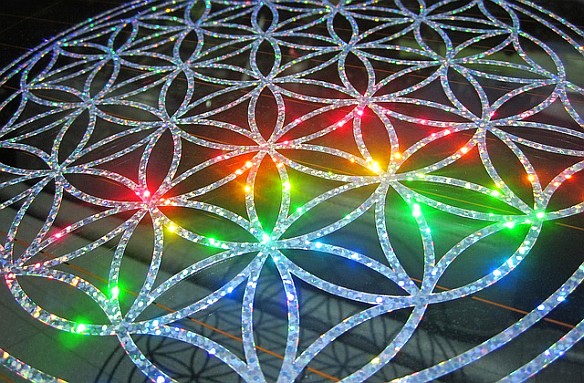A hologram has the property of containing the whole in each of its discrete parts
Everyone is familiar with the holograms embedded in our credit cards, those cool 3D images that appear lifelike when rotated at various angles. A hologram has the property of containing the whole in each of its discrete parts. You could think of a hologram as a 2D surface, like a flat photographic film, covered with little eyeballs at every point. Each of these eyeballs is viewing another object, say an apple, at some distance away from the surface. When each of these perspectives is recorded onto the 2D surface, together they create a 3D image of the apple. When rotated, the film then shows the apple from all different vantage points. The entire image is recorded by each eyeball at each point on the film. If you were to cut a rectangular chunk out of the corner of this 2D film, you would not see just a piece of the corner of the apple, but a smaller version of the entire 3D apple. In this way a hologram is said to contain the whole image in each one of its tiny discrete parts. Indeed, we could cut infinitely many smaller but similar rectangular pieces out of the film, and each one would contain the entire image of the apple.
One moment of experience arises, has a finite duration, and dies.
The twelve links and the interdependant origination of our entire reality have this same structure. I came to this realization when trying to find a more pragmatic explanation for birth and death. One need not think of birth and old age and death (the 11th and 12th links, respectively) as the beginning and end of life and rebirth into the next life. One can just as legitimately explain these as the birth and death of each existential moment of experience; each discrete split second quantum of experience we refer to as a dharma. It seems to me that our mind runs through the entire cycle of the twelve links as we create and recreate every split second of our experience. One moment of experience arises, has a finite duration, and dies. Within this interval our mind goes through every stage in the twelve links.
This is also true for a more coarse experience with a longer duration, say for example, the experience of one hour, one day, one lifetime, or even many lifetimes. All of these form an infinitely nested self-similar structure of experience at every scale, the twelve links being the basis of the self-similarity. This also expands out from the individual experience to our collective experience when we consider dharmas, as so elegantly stated in the description of this blog, as co-arising out of our collective consciousness, bringing “news of difference.” Thus we can see that the basis of our entire experience of reality is the same for an instantaneous discrete moment of individual experience as it is for our collective experience of the entire cosmos. The basis is ignorance and desire, and it appears to have a “holographic” structure. It is no wonder we are said to live in the desire realm. The entire fabric of our reality emanates from desire, and the whole process is contained in the twelve links. The entire cosmos exists within each moment of experience, and each moment of experience in the entire cosmos. As stated in the Avatamsaka Sutra: “The one is many and the many is one.”
The causes and conditons defining an individual object are nested within the overall causal matrix of the entire cosmos; nothing has any real individuality.
Furthermore it seems that the subject-object illusion melts away within the background of this self-similar holoraphic structure. This is like another perspective on emptiness: emptiness is traditionally described as an object having no fundamental independent existence of its own, because it is a collection of dynamic causes and conditions. The causes and conditons defining an individual object are nested within the overall causal matrix of the entire cosmos; nothing has any real individuality. It seems to me that this causal matrix is like a causal hologram, with all causes and conditions being nested within each other in a self-similar holographic structure. But I could be getting carried away at this point?

